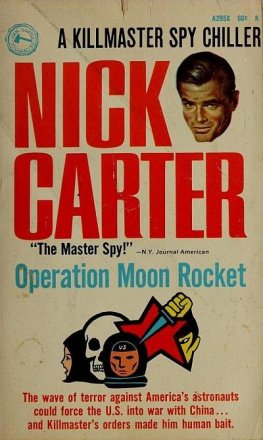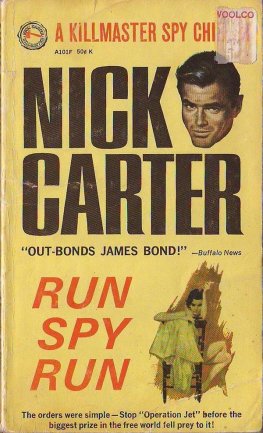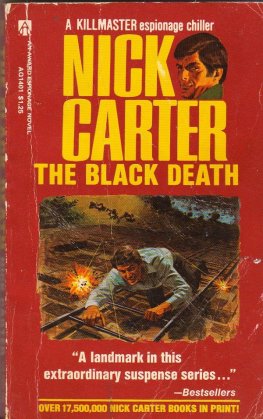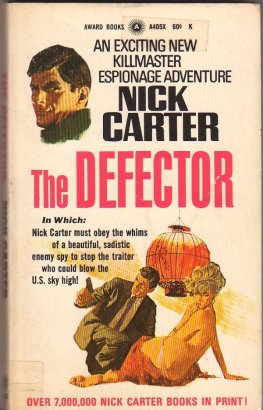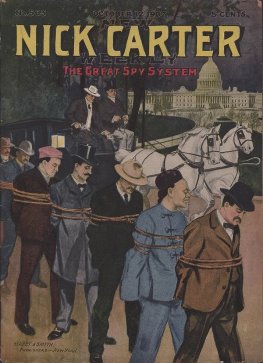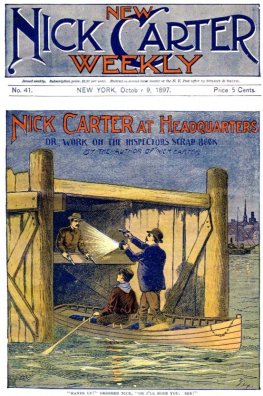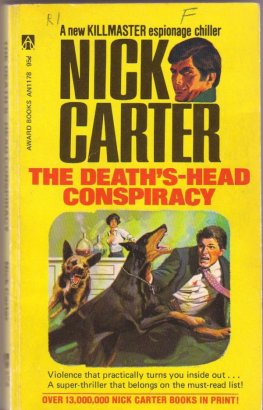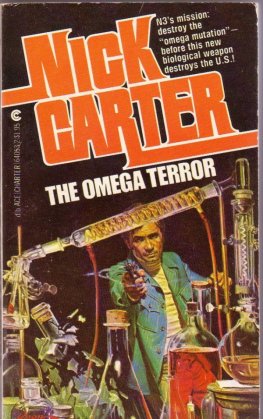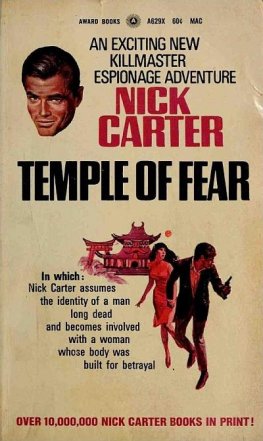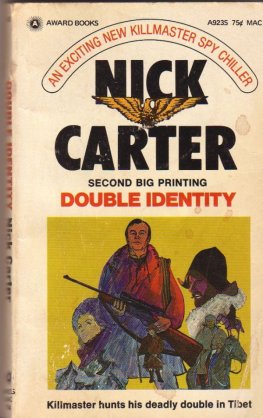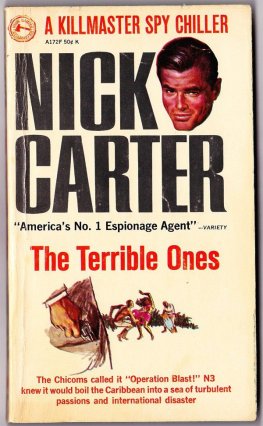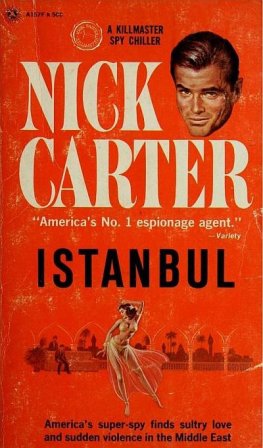Nick Carter
Operation Moon Rocket
Dedicated to The Men of the Secret Services of the United States of America.
At 6:10 a.m. est, May 16, the final countdown began.
Flight directors sat tensely before their control consoles at Houston, Texas, and Cape Kennedy, Florida. Ringing the earth was a fleet of tracking ships, a net of deep-space radio antennas and a number of hovering communications satellites. Worldwide television coverage began at 7:00 a.m. est, and those who had risen early to witness the event heard the Flight Director at Mission Control Center in Houston announce: "Everything is green and go."
Eight months earlier the Apollo spacecraft had been man-tested in orbit. Six months earlier the lunar landing craft had been space-tested. Two months after that the huge Saturn 5 rocket had made its unmanned flight debut. Now the three sections of the moon-ship had been joined and were ready for their first manned orbit the final test before the actual moon flight itself.
The three astronauts had started their day with a quick medical examination, followed by the customary steak-and-eggs breakfast. They were then driven by jeep across a bleak spit of sand and scrub called Merritt Island, out past those artifacts of an earlier space age the launching pads of Mercury and Gemini and past an orange grove that had somehow survived encircling technology to launching complex 39, a massive concrete platform half the size of a football field.
Chief pilot of the upcoming flight was Lieutenant Colonel Norwood "Woody" Liscombe, a gray-haired, laconic man in his early forties, a sober, no-nonsense veteran of the Mercury and Gemini programs. He squinted up at the haze hanging high over the launching area as the three men strolled from the jeep to the ready room. "Fine," he said in his slow Texas drawl. "It'll help keep the sun out of our eyes during lift-off."
His crewmates nodded. Lieutenant Colonel Ted Green, also a Gemini veteran, pulled out a colorful red bandana and mopped his forehead. "Must be up in the nineties already," he said. "If it gets any hotter they can just pour olive oil in on top of us."
Navy Lieutenant Commander Doug Albers laughed nervously. Boyish-looking, earnest, at thirty-two he was the youngest member of the team, the only one who hadn't yet been in space.
In the ready room the astronauts listened to a final mission briefing, then got into their space suits.
Out on the launching complex the pad crew had begun to fuel the Saturn 5 rocket. Because of the heat, the fuel and oxidizers had to be cooled to temperatures lower than usual and the operation was running twelve minutes late.
Above them, at the top of the fifty-five-story gantry elevator, a five-man crew of Connelly Aviation technicians had just given the thirty-ton Apollo capsule a final check. The Connelly Company of Sacramento was NASA's chief contractor on the $23 billion project, and a good eight percent of the personnel at the Kennedy moon port were employees of the California aerospace firm.
Gantry-crew chief Pat Hammer, a heavyset, square-faced man wearing white coveralls, a white baseball cap and hexagonal frameless polaroids, paused as he and his crew crossed the catwalk separating the Apollo capsule from the service tower. "You guys go on ahead," he called out. "I'm going to have a last look around."
One of the crew turned, shaking his head. "I've been through fifty launchings with you, Pat," he yelled, "but I've never seen you nervous till this one."
"You can't be too careful," Hammer said as he climbed back into the capsule.
He glanced around the interior, getting his bearings amid the maze of gauges, dials, switches, lights and toggles. Then, seeing what he wanted, he moved swiftly to his right, dropped to all fours and slithered under the astronauts' couches toward a bundle of wires that ran beneath a storage door.
He slipped his polaroids off, took a leather case from his hip pocket, opened it and put on a pair of plain rimless glasses. He pulled a pair of asbestos gloves from his back pocket and placed them next to his head. From the second and third fingers of the right glove he extracted a pair of wire cutters and a file.
He was breathing heavily now and beads of perspiration had started to trickle down his forehead. He slipped the gloves on, carefully chose a wire and proceeded to cut partially through it. Then he put the cutters down and started stripping the heavy Teflon insulation away until more than an inch of the glistening copper strands lay bare. He filed through one of the strands and peeled it away, bending it to within three inches of the soldered joint of some ECS piping
The astronauts moved across the concrete platform of complex 39 in their heavy moon suits. They paused to shake hands with some of the launching crewmen and Colonel Liscombe grinned when one of them handed him a three-foot mockup of a kitchen match. "When you're ready, Colonel," the technician said, "just strike it against a rough surface. Our rockets will do the rest"
Liscombe and the other astronauts nodded, grinning through their face plates, then moved to the gantry elevator and rose swiftly to the sterilized "white room" at spacecraft level.
Inside the capsule Pat Hammer had just finished filing through the soldered joint of the environment control piping. Quickly he gathered up his tools and gloves and crawled out from beneath the couches. Through the open hatchway he saw the astronauts emerge from the "white room" and start across the twenty-foot catwalk toward the stainless-steel hull of the capsule.
Hammer climbed to his feet, hurriedly stuffing the gloves into his back pocket. He forced a smile onto his lips as he stepped out of the hatchway. "Everything's A-OK, boys," he called out. "Have a good trip."
Colonel Liscombe suddenly stopped and swung toward him. Hammer winced, dodging an invisible blow. But the astronaut was grinning, holding the huge match out to him. His lips behind his face plate moved, saying, "Here, Pat next time you want to start a fire."
Hammer stood there, the match in his left hand, a smile frozen on his face as the three astronauts shook hands with him and climbed through the hatchway.
They hooked up their silvery nylon space suits to the environmental control system and lay back on their couches, waiting for them to become pressurized. Command pilot Liscombe was stretched out on the left under the flight-control panel. Green, assigned the job of navigator, was in the middle, and Albers was on the right where the communications equipment was located.
At 7:50 A.M., pressurization was completed. The airtight double hatch plates were sealed and the atmosphere inside the spacecraft filled with oxygen and pressurized at sixteen pounds per square inch.
Now began the familiar routine, an infinitely detailed run-through scheduled to last more than five hours.
At the end of four and a half, the countdown had been stopped twice, both times for minor "glitches." Then, at countdown-minus-fourteen-minutes, the procedure was stopped once again this time because of static in the communications channels between the spacecraft and technicians at the operations center. When it had cleared, the countdown scenario continued. The next steps called for switching of electrical equipment and checking the Glycol the coolant used in the ship's environmental control system.
Commander Albers flicked a switch labeled 11-CT. Impulses from the switch ran through the wire, bridging the section from which the Teflon insulation had been removed. Two steps later Colonel Liscombe turned a valve that sent highly combustible Ethylene Glycol through an alternate pipeline and through a soldered joint which had been carefully filed through. The instant that the first drop of Glycol splashed onto the bare, overheated wire marked the moment when the mists of eternity opened for the three men aboard Apollo AS-906.

